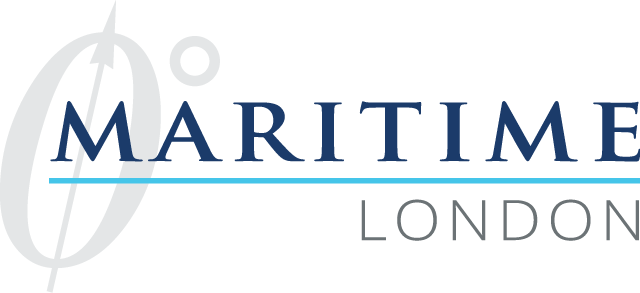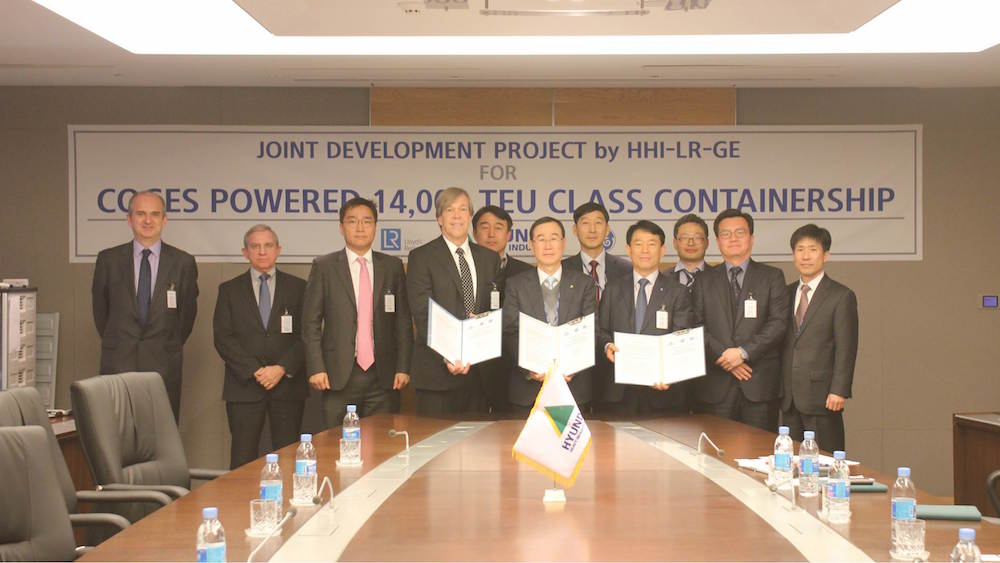Posted on: 24 March 2016
With LNG fuelled gas turbines and electric motors, the design will be a clean powered ship with maximum efficiency and operational speed flexibility
Project further develops HHI and LR’s work on maximised and safe container loading and continues GE’s collaboration with LR on the COGES (COmbined Gas turbine, Electric and Steam) propulsion and power system technology.
The joint development project was signed on 15 March in Seoul by General Electric (GE), Hyundai Heavy Industries (HHI) and Lloyd’s Register’s (LR), and is the latest step in the development of gas turbine powered ship designs suitable for deep sea, commercial applications.
While gas turbines are a proven technology and have been used at sea in naval ships and high speed craft, as well as in passenger ships, the benefits of gas turbines have not yet been applied to mainstream cargo shipping. This project will develop a design to safely maximise the potential operational benefits of gas turbine systems.
Brien Bolsinger, GE VP Marine operations, explains that COGES offers a combination of advantages: “Operational benefits of gas turbines to naval architects, owners and operators include high power in a compact package and design flexibility. The gas turbine is so lightweight – fully 80% lighter and 30% smaller than comparable slow-speed diesel applications – that it can be located anywhere on the ship.
“The design will allow for flexible configuration and, with GE’s portfolio of gas turbines, total installed power can easily meet today’s highest requirements. The GE gas turbines can be equipped with a GE Dry Low Emissions (DLE) or single annular combustion system – both capable of meeting Tier III IMO/Tier IV United States Environmental Protection Agency requirements now with no exhaust treatment and no methane slip. The turbines can run on diesel as well as gas, if required – providing further flexibility.”
COGES also opens the way for new thinking on maintenance and financing of ships. With gas turbines, for example, finance could be arranged on a ‘power-by-the-hour’ basis and maintenance could see the swapping in and out of an entire gas turbine within 24 hours. These options reduce down time and enable maintenance conditions without getting in the way of ship operations – ideal for the container trades.
Byeong-Rok Lee, Senior Vice President, Head of Initial Design Office, Hyundai Heavy Industries, said that he expects technological innovation of the 14,000 TEU class container ship, which is the main product of HHI, will provide a brand new vision for future container ships with enhanced operational efficiency and flexibility from the increased container intake and environmentally friendly dual fuel system provided by the COGES system.
In response, Jin-Tae Lee, Ph.D, Korea Chief Representative & Marine Manager, Lloyd’s Register Asia, emphasised the importance of technical innovation following the paradigm shift in the shipping and shipbuilding industries. He also added that he expected this kind of co-operation would be a cornerstone which would prepare all interested stakeholders for the future upturn in business. LR has steadfastly reinforced the investment through Joint Development and Joint Industry projects with the shipyards, focusing on ‘technology enabled and agile’ projects, in order to take the technical leadership to the next level since his inauguration in April 2015.
Lloyd’s Register and GE have worked together on a number of joint development projects related to gas turbines. Notably on a design for a gas turbine powered LNG carrier introduced to the market in 2013 which, LR Approval in Principle (AiP) was issued in December 2015.
The 14K project will be technically led by LR’s Busan Technical Support Office engineering experts and facilitated by Sung-Gu Park, Lloyd’s Register’s Design Innovation Strategic Marketing Manager, based at the Southampton Global Technology Centre, who commented: “We will take this from the ground up through to hazard identification (HAZID) studies and a COGES Operation Modes evaluation. We will be looking at the design’s power station configuration, hazardous areas, structural integrity, safe separation, pipe routing and ventilation. These studies will help mature the design and minimize risk for GE’s COGES and HHI’s container ships system. We will also be able to evaluate technical risks including the gas combustion unit and compressors with the equipment makers to help ensure safety and operability.
“We are here to provide the assurance required to develop a safe, dependable, optimised capability design so that forward thinking owners are able to make the best commercial decisions based on the best technical understanding.”




